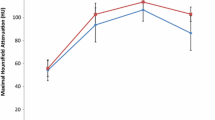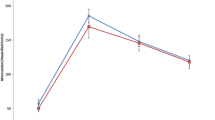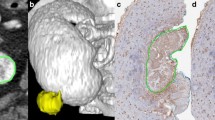Abstract
Purpose
To investigate whether multiphasic MDCT enhancement profiles can help to identify PTEN expression in clear cell renal cell carcinomas (ccRCCs). Lack of PTEN expression is associated with worsened overall survival, a more advanced Fuhrman grade, and a greater likelihood of lymph mode metastasis.
Methods
With IRB approval for this retrospective study, we derived a cohort of 103 histologically proven ccRCCs with preoperative 4-phase renal mass MDCT from 2001–2013. Following manual segmentation, a computer-assisted detection algorithm selected a 0.5-cm-diameter region of maximal attenuation within each lesion in each phase; a 0.5-cm-diameter region of interest was manually placed on uninvolved renal cortex in each phase. The relative attenuation of each lesion was calculated as [(Maximal lesion attenuation − cortex attenuation)/cortex attenuation] × 100. Absolute and relative attenuation in each phase were compared using t tests. The performance of multiphasic enhancement in identifying PTEN expression was assessed with logistic regression analysis.
Results
PTEN-positive and PTEN-negative ccRCCs both exhibited peak enhancement in the corticomedullary phase. Relative corticomedullary phase attenuation was significantly greater for PTEN-negative ccRCCs in comparison to PTEN-positive ccRCCs (33.7 vs. 9.5, p = 0.03). After controlling for lesion stage and size, relative corticomedullary phase attenuation had an accuracy of 84% (86/103), specificity of 100% (84/84), sensitivity of 11% (2/19), positive predictive value of 100% (2/2), and negative predictive value of 83% (84/101) in identifying PTEN expression.
Conclusion
Relative corticomedullary phase attenuation may help to identify PTEN expression in ccRCCs, if validated prospectively.




Similar content being viewed by others

References
Gore ME, Larkin JM (2011) Challenges and opportunities for converting renal cell carcinoma into a chronic disease with targeted therapies. Br J Cancer 104(3):399–406. https://doi.org/10.1038/sj.bjc.6606084
Srigley JR, Delahunt B, Eble JN, et al. (2013) The international society of urological pathology (ISUP) vancouver classification of renal neoplasia. Am J Surg Pathol 37(10):1469–1489. https://doi.org/10.1097/PAS.0b013e318299f2d1
Kovacs G, Akhtar M, Beckwith BJ, et al. (1997) The Heidelberg classification of renal cell tumours. J Pathol 183(2):131–133.https://doi.org/10.1002/(sici)1096-9896(199710)183:22%3C131::aid-path931%3E3.0.co;2-g
Truong LD, Shen SS (2011) Immunohistochemical diagnosis of renal neoplasms. Arch Pathol Lab Med 135(1):92–109. https://doi.org/10.1043/2010-0478-rar.1
Cheville JC, Lohse CM, Zincke H, Weaver AL, Blute ML (2003) Comparisons of outcome and prognostic features among histologic subtypes of renal cell carcinoma. Am J Surg Pathol 27(5):612–624
Hoffmann NE, Gillett MD, Cheville JC, et al. (2008) Differences in organ system of distant metastasis by renal cell carcinoma subtype. J Urol 179(2):474–477. https://doi.org/10.1016/j.juro.2007.09.036
Amin MB, Corless CL, Renshaw AA, et al. (1997) Papillary (chromophil) renal cell carcinoma: histomorphologic characteristics and evaluation of conventional pathologic prognostic parameters in 62 cases. Am J Surg Pathol 21(6):621–635
Beck SD, Patel MI, Snyder ME, et al. (2004) Effect of papillary and chromophobe cell type on disease-free survival after nephrectomy for renal cell carcinoma. Ann Surg Oncol 11(1):71–77
Moch H, Gasser T, Amin MB, et al. (2000) Prognostic utility of the recently recommended histologic classification and revised TNM staging system of renal cell carcinoma: a Swiss experience with 588 tumors. Cancer 89(3):604–614
Young JR, Margolis D, Sauk S, et al. (2013) Clear cell renal cell carcinoma: discrimination from other renal cell carcinoma subtypes and oncocytoma at multiphasic multidetector CT. Radiology 267(2):444–453. https://doi.org/10.1148/radiol.13112617
Lee-Felker SA, Felker ER, Tan N, et al. (2014) Qualitative and quantitative MDCT features for differentiating clear cell renal cell carcinoma from other solid renal cortical masses. AJR 203(5):W516–W524. https://doi.org/10.2214/ajr.14.12460
Coy H, Young JR, Douek ML, et al. (2017) Quantitative computer-aided diagnostic algorithm for automated detection of peak lesion attenuation in differentiating clear cell from papillary and chromophobe renal cell carcinoma, oncocytoma, and fat-poor angiomyolipoma on multiphasic multidetector computed tomography. Abdom Radiol (New York) 42(7):1919–1928. https://doi.org/10.1007/s00261-017-1095-6
Zhang J, Lefkowitz RA, Ishill NM, et al. (2007) Solid renal cortical tumors: differentiation with CT. Radiology 244(2):494–504. https://doi.org/10.1148/radiol.2442060927
Kim JK, Kim TK, Ahn HJ, et al. (2002) Differentiation of subtypes of renal cell carcinoma on helical CT scans. AJR 178(6):1499–1506. https://doi.org/10.2214/ajr.178.6.1781499
Sheir KZ, El-Azab M, Mosbah A, El-Baz M, Shaaban AA (2005) Differentiation of renal cell carcinoma subtypes by multislice computerized tomography. J Urol 174(2):451–455 ((discussion 455)). https://doi.org/10.1097/01.ju.0000165341.08396.a9
Jinzaki M, Tanimoto A, Mukai M, et al. (2000) Double-phase helical CT of small renal parenchymal neoplasms: correlation with pathologic findings and tumor angiogenesis. J Comput Assist Tomogr 24(6):835–842
Ruppert-Kohlmayr AJ, Uggowitzer M, Meissnitzer T, Ruppert G (2004) Differentiation of renal clear cell carcinoma and renal papillary carcinoma using quantitative CT enhancement parameters. AJR 183(5):1387–1391. https://doi.org/10.2214/ajr.183.5.1831387
Zhu C, Wei J, Tian X, Li Y, Li X (2015) Prognostic role of PPAR-γ and PTEN in the renal cell carcinoma. Int J Clin Exp Pathol 8(10):12668–12677
Rosenkrantz AB, Matza BW, Portnoy E, et al. (2014) Impact of size of region-of-interest on differentiation of renal cell carcinoma and renal cysts on multi-phase CT: preliminary findings. Eur J Radiol 83(2):239–244. https://doi.org/10.1016/j.ejrad.2013.10.020
Young JR, Coy H, Douek M, et al. (2017) Type 1 papillary renal cell carcinoma: differentiation from type 2 papillary RCC on multiphasic MDCT. Abdom Radiol (New York) 42(7):1911–1918. https://doi.org/10.1007/s00261-017-1091-x
Young JR, Coy H, Douek M, et al. (2017) Clear cell renal cell carcinoma: identifying the gain of chromosome 12 on multiphasic MDCT. Abdom Radiol (New York) 42(1):236–241. https://doi.org/10.1007/s00261-016-0868-7
Young JR, Coy H, Kim HJ, et al. (2017) Performance of relative enhancement on multiphasic MRI for the differentiation of clear cell renal cell carcinoma (RCC) from papillary and chromophobe RCC subtypes and oncocytoma. AJR 208(4):812–819. https://doi.org/10.2214/ajr.16.17152
Young JR, Margolis D, Sauk S, et al. (2014) Clear cell renal cell carcinoma: multiphasic MDCT enhancement can predict the loss of chromosome 8p. Abdom Imaging 39(3):543–549. https://doi.org/10.1007/s00261-014-0092-2
Young JR, Young JA, Margolis DJ, et al. (2016) Clear cell renal cell carcinoma: identifying the gain of chromosome 20 on multiphasic MDCT. Abdom Radiol (New York) 41(11):2175–2181. https://doi.org/10.1007/s00261-016-0813-9
Young JR, Coy H, Douek M, et al. (2017) Clear cell renal cell carcinoma: identifying the loss of the Y chromosome on multiphasic MDCT. AJR 209(2):333–338. https://doi.org/10.2214/ajr.16.17010
Young JR, Coy H, Kim HJ, et al. (2018) Utility of multiphasic multidetector computed tomography in discriminating between clear cell renal cell carcinomas with high and low carbonic anhydrase-IX expression. Abdom Radiol (New York) . https://doi.org/10.1007/s00261-018-1546-8
Westfall PH, Krishen A (2001) Optimally weighted, fixed sequence and gatekeeper multiple testing procedures. J Stat Plan Inference 99(1):25–40. https://doi.org/10.1016/S0378-3758(01)00077-5
Rodriguez S, Huynh-Do U (2012) The role of PTEN in tumor angiogenesis. J Oncol 2012:11. https://doi.org/10.1155/2012/141236
Liu L, Li Y, Liu S, et al. (2017) Downregulation of miR-193a-3p inhibits cell growth and migration in renal cell carcinoma by targeting PTEN. Tumour Biol 39(6):1010428317711951. https://doi.org/10.1177/1010428317711951
Guo H, German P, Bai S, et al. (2015) The PI3K/AKT pathway and renal cell carcinoma. J Genet Genom 42(7):343–353. https://doi.org/10.1016/j.jgg.2015.03.003
Gerlinger M, Rowan AJ, Horswell S, et al. (2012) Intratumor heterogeneity and branched evolution revealed by multiregion sequencing. N Engl J Med 366(10):883–892. https://doi.org/10.1056/NEJMoa1113205
Acknowledgements
This study was funded by the Society of Abdominal Radiology Howard S. Stern Research Grant. We thank the UCLA Computer Vision and Imaging Biomarker (CVIB) group, including Dr. Jonathan Goldin, Dr. Matthew Brown, Moe Moe Ko, and War War Ko, for their assistance with this study.
Author information
Authors and Affiliations
Corresponding author
Ethics declarations
Conflict of interest
The authors declare that they have no conflicts of interest.
Ethical approval
All procedures performed in studies involving human participants were in accordance with the ethical standards of the institutional and/or national research committee and with the 1964 Helsinki declaration and its later amendments or comparable ethical standards.
Informed consent
The Institutional Review Board waived the requirement of informed consent for this study.
Rights and permissions
About this article
Cite this article
Young, J.R., Coy, H., Kim, H.J. et al. Clear cell renal cell carcinoma: identifying PTEN expression on multiphasic MDCT. Abdom Radiol 43, 3410–3417 (2018). https://doi.org/10.1007/s00261-018-1672-3
Published:
Issue Date:
DOI: https://doi.org/10.1007/s00261-018-1672-3



